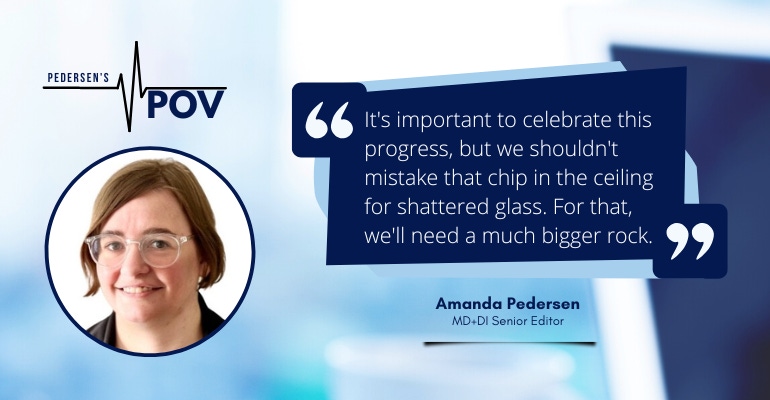This week in Pedersen's POV, our senior editor warns industry not to mistake a chip in the ceiling for shattered glass.
November 7, 2022

Unprecedented turnover in the c-suite, combined with an increased focus on diversity, equity, and inclusion initiatives, has chipped the glass ceiling for women in corporate America.
Citing the most recent data published by Challenger, Gray & Christmas, MD+DI reported last week that the percentage of women taking on CEO roles is above 26%, a significant increase from the 12% reported in 2010.
This is good news not just for women leaders, but for the companies these women lead. There's no shortage of research showing that women-led companies show better returns, and are more innovative. Last year, the Harvard Business Review (HBR) published a ground-breaking analysis to explain why having more female executives is associated with better business outcomes.
The HBR tracked appointments of male and female executives and analyzed R&D expenses, merger and acquisition rates, and the content of letters to shareholders for 163 multinational companies over 13 years to determine how these firms’ long-term strategies shifted after women joined their top management teams. The publication was able to identify three distinct trends around shifts in firms’ strategic thinking following the appointment of female executives: Firms became more open to change and less open to risk; Firms shifted focus from M&A to R&D; The impact of female appointments was greater when women were well-integrated into the top management team. This last trend is largely influenced by whether the female executive is the only woman on the top management team, and whether she's one of many new appointees.
Challenger, Gray & Christmas found the number of female CEOs replacing male CEOs (149) in 2022 is higher than the number of women CEOs replacing other women (86) and higher than the number of male CEOs replacing female CEOs (77). The report also notes one non-binary executive who replaced a male CEO in 2022.
While 26% is a vast improvement over 12% in 2010, and a marked improvement over 22% in 2019 and 2020, but Colleen Madden Blumenfeld, vice president of public relations and research at Challenger, Gray & Christmas, said it is still far below equitable with male counterparts.
"Certainly, corporate commitments to diversity, equity, inclusion, and belonging, and the impact of the MeToo movements, have moved the needle on feeding much-needed women talent into the c-suite pipeline," Blumenfeld said. "But if it stalls at around a quarter of new CEOs, it will be a disservice, not just to the women who deserve to lead companies, but to the companies themselves.”
So, it's important to celebrate this progress, but we shouldn't mistake that chip in the ceiling for shattered glass. For that, we'll need a much bigger rock – or maybe a wrecking ball.
Pedersen's POV publishes every Monday. If there’s a topic you would like her to consider, email [email protected] (please put “POV” in the subject line).
About the Author(s)
You May Also Like




